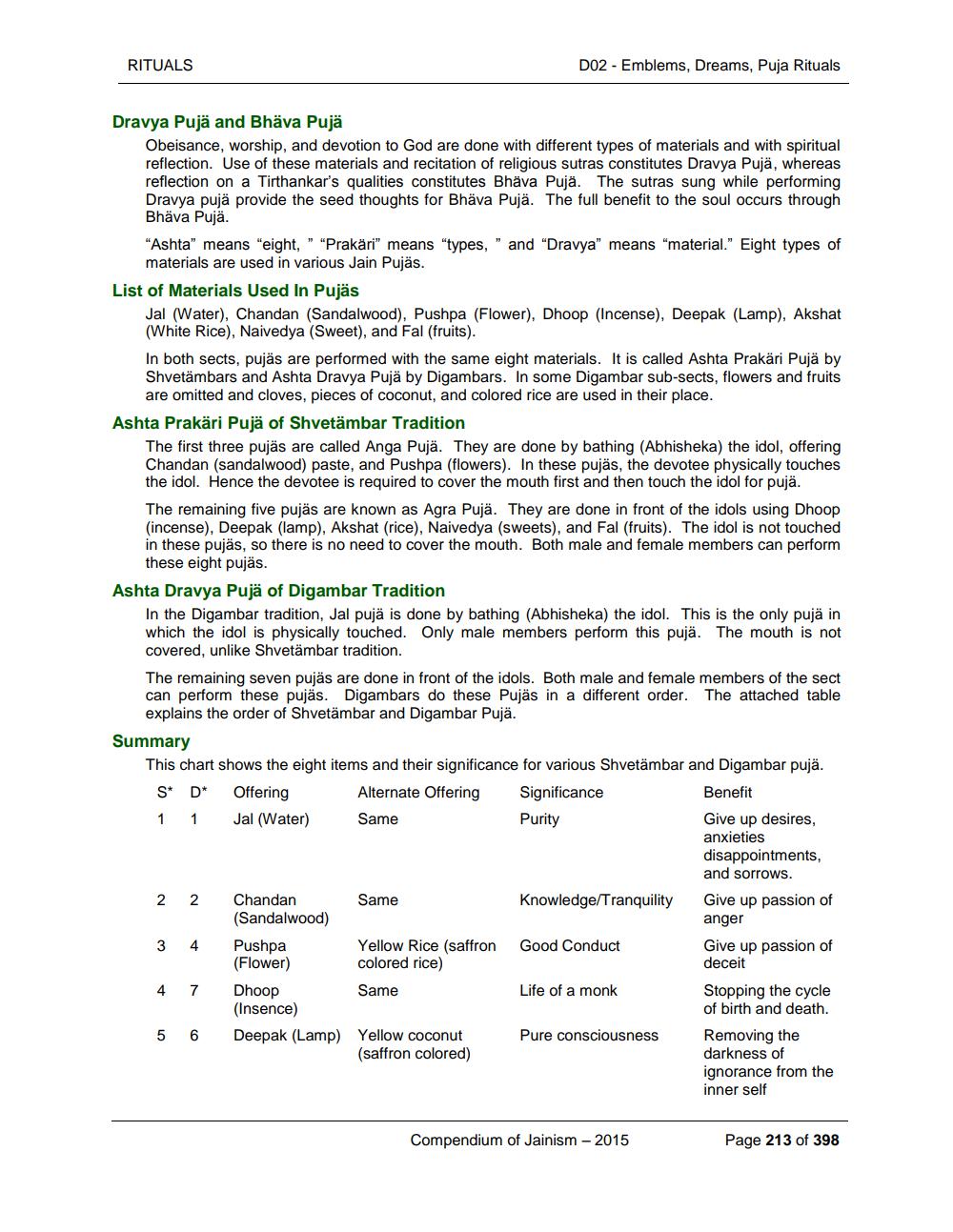________________
RITUALS
Dravya Pujä and Bhäva Pujä
Obeisance, worship, and devotion to God are done with different types of materials and with spiritual reflection. Use of these materials and recitation of religious sutras constitutes Dravya Pujä, whereas reflection on a Tirthankar's qualities constitutes Bhäva Pujä. The sutras sung while performing Dravya pujä provide the seed thoughts for Bhäva Pujä. The full benefit to the soul occurs through Bhäva Pujä.
"Ashta" means "eight," "Prakäri" means "types," and "Dravya" means "material." Eight types of materials are used in various Jain Pujäs.
List of Materials Used In Pujäs
Jal (Water), Chandan (Sandalwood), Pushpa (Flower), Dhoop (Incense), Deepak (Lamp), Akshat (White Rice), Naivedya (Sweet), and Fal (fruits).
In both sects, pujäs are performed with the same eight materials. It is called Ashta Prakäri Pujä by Shvetämbars and Ashta Dravya Pujä by Digambars. In some Digambar sub-sects, flowers and fruits are omitted and cloves, pieces of coconut, and colored rice are used in their place.
Ashta Prakäri Pujä of Shvetämbar Tradition
The first three pujäs are called Anga Pujä. They are done by bathing (Abhisheka) the idol, offering Chandan (sandalwood) paste, and Pushpa (flowers). In these pujäs, the devotee physically touches the idol. Hence the devotee is required to cover the mouth first and then touch the idol for pujä.
The remaining five pujäs are known as Agra Pujä. They are done in front of the idols using Dhoop (incense), Deepak (lamp), Akshat (rice), Naivedya (sweets), and Fal (fruits). The idol is not touched in these pujäs, so there is no need to cover the mouth. Both male and female members can perform these eight pujäs.
Ashta Dravya Pujä of Digambar Tradition
In the Digambar tradition, Jal pujä is done by bathing (Abhisheka) the idol. This is the only pujä in which the idol is physically touched. Only male members perform this pujä. The mouth is not covered, unlike Shvetämbar tradition.
The remaining seven pujäs are done in front of the idols. Both male and female members of the sect can perform these pujäs. Digambars do these Pujäs in a different order. The attached table explains the order of Shvetämbar and Digambar Pujä.
Summary
This chart shows the eight items and their significance for various Shvetämbar and Digambar pujä.
S* D*
Offering Jal (Water)
Alternate Offering Same
Significance Purity
1 1
2 2
3
D02 - Emblems, Dreams, Puja Rituals
4
4
7
5 6
Chandan (Sandalwood)
Pushpa (Flower)
Dhoop (Insence)
Deepak (Lamp)
Same
Yellow coconut (saffron colored)
Knowledge/Tranquility
Yellow Rice (saffron Good Conduct colored rice)
Same
Life of a monk
Pure consciousness
Compendium of Jainism - 2015
Benefit
Give up desires, anxieties disappointments, and sorrows.
Give up passion of anger
Give up passion of deceit
Stopping the cycle of birth and death.
Removing the darkness of ignorance from the inner self
Page 213 of 398




